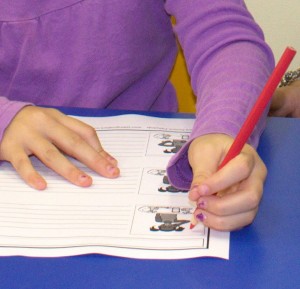 Language skills have a big impact on school achievement. There are many strategies that can help children with language difficulties manage tasks better and so learn more effectively. Whether you are a parent wanting to help your child with homework, a teacher wanting to support a language disordered student in your class or a school support worker wanting to help out a student in your care here are some support strategies for middle primary and older students with language difficulties.
Language skills have a big impact on school achievement. There are many strategies that can help children with language difficulties manage tasks better and so learn more effectively. Whether you are a parent wanting to help your child with homework, a teacher wanting to support a language disordered student in your class or a school support worker wanting to help out a student in your care here are some support strategies for middle primary and older students with language difficulties.
Students with language difficulties can benefit from support to cope with the demands of communicating and learning both at home and school. A formal language assessment by a qualified and experienced speech pathologist will provide specific strategies for a student’s individual needs. The information below is general and is not designed to replace individual assessment and therapy.
Here are some general ideas which may be helpful:
Strategies for good learning habits:
- Provide opportunities for quiet focused individual work as the language demands of the classroom are tiring for a student with language learning difficulties.
- Break times are also helpful to allow students to refocus.
- Encourage students to take their time. Students can be impulsive and ‘rush into’ tasks. Encourage careful thinking about tasks before attempting them.
- Provide opportunities for some work to be completed with other students who are able to be good role models for language and communication.
- Provide opportunities for the student to discuss their understanding of information and tasks before completing them.
- Teach students to check their work for text structure, spelling and grammar as well as meaning.
- Teach the student to use a dictionary to check unfamiliar words.
- Teach use of a thesaurus to develop vocabulary.
- Encourage them to check their understanding of a task and request clarification as needed.
- Teach note taking, planning and drafting skills. Encourage students to produce a draft of work and ask for feedback prior to presenting a final copy.
 Strategies to support listening:
Strategies to support listening:
- Reduce visual distractions such as not having the student sit by windows, doors or corridors. Seating near the front of the class helps with focus and attention.
- Reduce noise distractions such as by sitting student away from noisy students, corridors air-conditioners etc.
- Gain the student's attention before giving instructions.
- Give short simple instructions.
- Emphasise key words.
- Break complex instructions down into parts or steps.
- Repeat instructions to the student individually if required.
Provide visual supports whenever possible, such as :
- Providing maps, diagrams, pictures or video were possible.
- Writing keywords on the board.
- Providing a demonstration of tasks.
- Providing opportunities for hands-on activities were possible.
- Providing checklists or outlines for tasks.
- Providing a written copy of spoken information and encouraging the student to highlight key points as they listen.
- Placing checklists, key word lists and frequent word lists on the students desk.
- Making a personal book with key words, frequently used spelling words and text maps with the student and teaching them how and when to use it.
- Colour coding the items needed for different subjects, such as notebooks and text books and use a matching colour code in their diary or timetable.
Assist the student with understanding information presented by:
- Pre-teaching new vocabulary and concepts before presenting a unit of work.
- Highlighting key words and concepts.
- Linking new information to known information.
- Providing opportunities for repetition as required.
- Allowing extra time to process the new information or concepts.
 Assist the student to better present information by:
Assist the student to better present information by:
- Providing lists of key vocabulary.
- Linking new information to known information.
- Encouraging the student to use text maps, graphic organisers and minds maps to plan texts.
- Encouraging the student to talk through information before recording it.
- Encouraging the student to brainstorm, plan, draft and edit work.
- Using technology and/or scribes were needed.
- Considering the use of voice to text technology
- Using alternative forms of presenting work of such as oral presentations, models, posters, timelines, PowerPoint presentations, recorded information.
Develop the student’s use of correct language structures by:
- Explicitly teaching the structure of written texts.
- Explicitly teaching structure of sentences and the use of grammatical structures.
- Teaching verb tenses and conjunctions which are often structures students find particularly difficult. They may benefit from repetitive activities such as a sentence completion tasks to develop competence with these.
- Encouraging students to read their own work out loud. This often makes grammatical errors easier to detect.
- Encouraging students to draft and edit their work. Encourage them to seek feedback at the editing stage.
- Developing the student's ability to use a word processor with spelling and grammar checks.
Related Blog Posts
If you liked this post you may also like:
Using TANGRAM PUZZLES To Grow
Learning to Move
10 ways to boost your superpowers!
Self esteem



